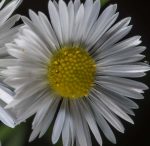 Also known as rose petty, blue spring-daisy, and Robert’s plantian, this herbaceous biennial or short-lived perennial is a member of the aster family Asteraceae, that also includes sunflower, yarrow, and lettuce. It is native to eastern and southcentral US from Maine and Ontario to southeast Minnesota south to Florida, Mississippi and Texas where it grows in open woods, fields, streambanks, roadsides and disturbed sites. Plants grow 18-24″ tall from the crown of a fibrous root system with rhizomes or stolons, and has a rosette of paddle-shaped hairy leaves up to 5″ long with a single flowering stems. This stem is hairy, 12-24″ tall, and bears alternate sessile leaves and loose clusters of 2-9 flower heads from mid spring to early summer. Each flower head is up to 1 1/4″ across and consists of up to 100 white, pink, pale blue or lavender ray flowers surrounding a center of yellow disc flowers. The fruit is a tufted achene. The flowers are attractive to bees and butterflies and the plants are valued for their use as a ground cover and in rock, cottage, native plant, butterfly, wildlife, and wildflower gardens. The genus name, Erigeron, comes from the Greek words ἦρι (êri) meaning early referring to the early bloom tme, and γέρων (gérōn) meaning old man, referring to the hairy appearance of the fruit that resembles the beard of an old man. The specific epithet, pullchellus, is the diminutive of the Latin word pulcher, meaning beautiful.
Also known as rose petty, blue spring-daisy, and Robert’s plantian, this herbaceous biennial or short-lived perennial is a member of the aster family Asteraceae, that also includes sunflower, yarrow, and lettuce. It is native to eastern and southcentral US from Maine and Ontario to southeast Minnesota south to Florida, Mississippi and Texas where it grows in open woods, fields, streambanks, roadsides and disturbed sites. Plants grow 18-24″ tall from the crown of a fibrous root system with rhizomes or stolons, and has a rosette of paddle-shaped hairy leaves up to 5″ long with a single flowering stems. This stem is hairy, 12-24″ tall, and bears alternate sessile leaves and loose clusters of 2-9 flower heads from mid spring to early summer. Each flower head is up to 1 1/4″ across and consists of up to 100 white, pink, pale blue or lavender ray flowers surrounding a center of yellow disc flowers. The fruit is a tufted achene. The flowers are attractive to bees and butterflies and the plants are valued for their use as a ground cover and in rock, cottage, native plant, butterfly, wildlife, and wildflower gardens. The genus name, Erigeron, comes from the Greek words ἦρι (êri) meaning early referring to the early bloom tme, and γέρων (gérōn) meaning old man, referring to the hairy appearance of the fruit that resembles the beard of an old man. The specific epithet, pullchellus, is the diminutive of the Latin word pulcher, meaning beautiful.
Type: Biennial or short-lived perennial
Bloom: Pink or white to lavender flower heads with yellow disc from mid spring to early summer
Size: 18-24″ H x 18-24″ W
Light: Full to part sun
Soil: Average, dry to medium moist, well-drained
Hardiness: Zones 3-8
Care: Low maintenance
Pests and Diseases: Generally healthy but susceptible to powdery mildew, rust, leaf spot
Propagation: Seed, division
Companion Plants: Japanese parley, grape hyacinth, small columbines
Outstanding Selections: ‘Lynnhaven Carpet’